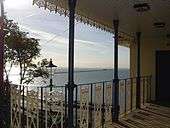Southend Cliff Railway
The Southend Cliff Railway, or Southend Cliff Lift, is a funicular in the English town of Southend-on-Sea, constructed in 1912.[1][2] The lift operated for the first time on Bank Holiday Monday, in August of that year.[3]



Technical details
The line is owned and operated by the Museums Service of Southend-on-Sea Borough Council, and has the following technical parameters:[1][2][4]
- Length: 130 feet (40 m)
- Height difference: 57 feet (17 m)
- Gradient: 43,4%
- Cars: 1
- Capacity: 12 passengers per car
- Configuration: Single track, with separate counterweight track
- Main track gauge: 4 ft 6 in (1,372 mm)
- Counterweight track gauge: 21 in (533 mm)
- Traction: Electricity
The line has an unusual configuration, as it runs on a single-track elevated structure. The counterweight track runs within this structure, immediately below the main track that carries the passenger car.[1][2]
Operation
The line operates daily between 10:00 am and 3:00 pm subject to the availability of volunteer drivers and weather conditions. A fare of fifty pence is charged for each single journey.[5][6]
History
The line runs on the site of a pioneering moving walkway, a forerunner of today's escalator. This was constructed in 1901 by the American engineer Jesse W. Reno, but soon proved noisy and unreliable due its exposed location.[3] The current lift was constructed by Waygood & Company,[3] now part of the Otis Elevator Company. Since opening in 1912 it has been modernised three times, in 1930, 1959 and 1990. Each modernisation has resulted in the replacement of the car.[2]
In 2003 the line was closed due to technical problems, and refurbishment was undertaken on the stations. However, during the time that it was closed, the regulations governing its operation changed, requiring modifications before it could be reopened.[7] The line finally re-opened on 25 May 2010, after a restoration costing a total of £3 million, £650,000 on the car alone.[6][8][9]
References
- "Southend Pier Railway". www.nycsubway.org. Retrieved 9 March 2008.
- "Southend Cliff Railway". The Heritage Trail. Archived from the original on 7 June 2009. Retrieved 15 May 2009.
- Southend Museums Service (2010). Cliff Lift History (leaflet)
|format=requires|url=(help). Southend-on-Sea: Southend Museums Service. - "Southend Lift". Funiculars.net. Retrieved 15 May 2009.
- Toms, Adam. "The Cliff Lift". www.southend.gov.uk. Retrieved 12 May 2017.
- "Historic cliff lift reopens following refurbishment". BBC. 25 May 2010. Retrieved 16 August 2010.
- "Southend Cliff Railway - www.simplonpc.co.uk". www.simplonpc.co.uk. Retrieved 12 May 2017.
- "Cliff Lift". Southend-on-Sea Borough Council. 2 February 2009. Archived from the original on 7 October 2007. Retrieved 18 May 2009.
- Percival, Geoff (13 May 2008). "Cliffs Lift to remain closed another year". Echo. Newsquest Media Group. Retrieved 18 May 2009.
External links
| Wikimedia Commons has media related to Southend Cliff Railway. |